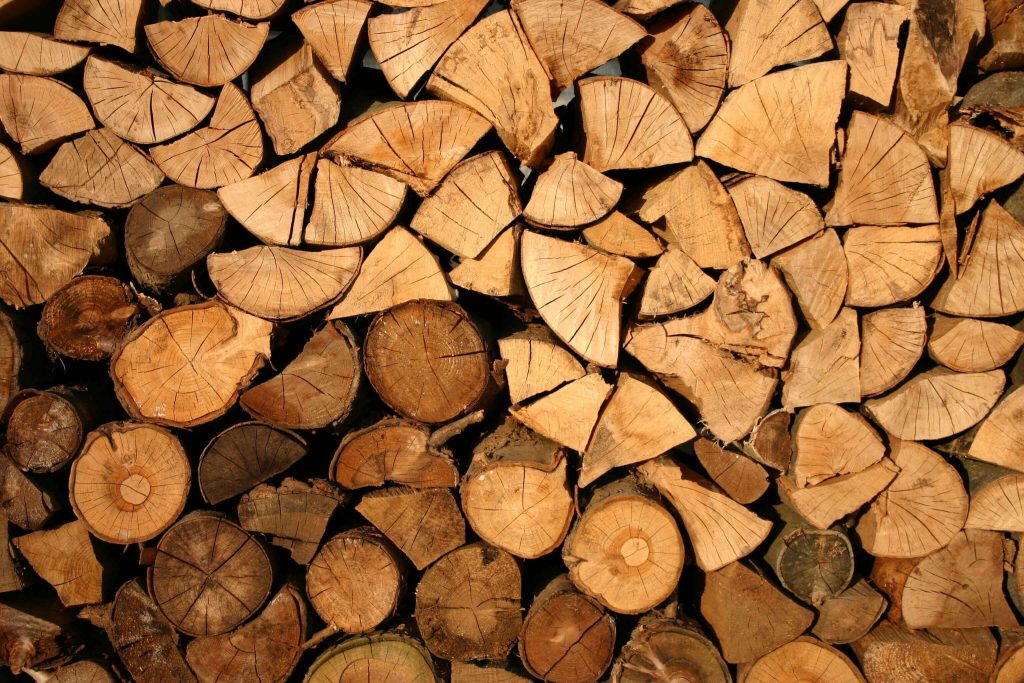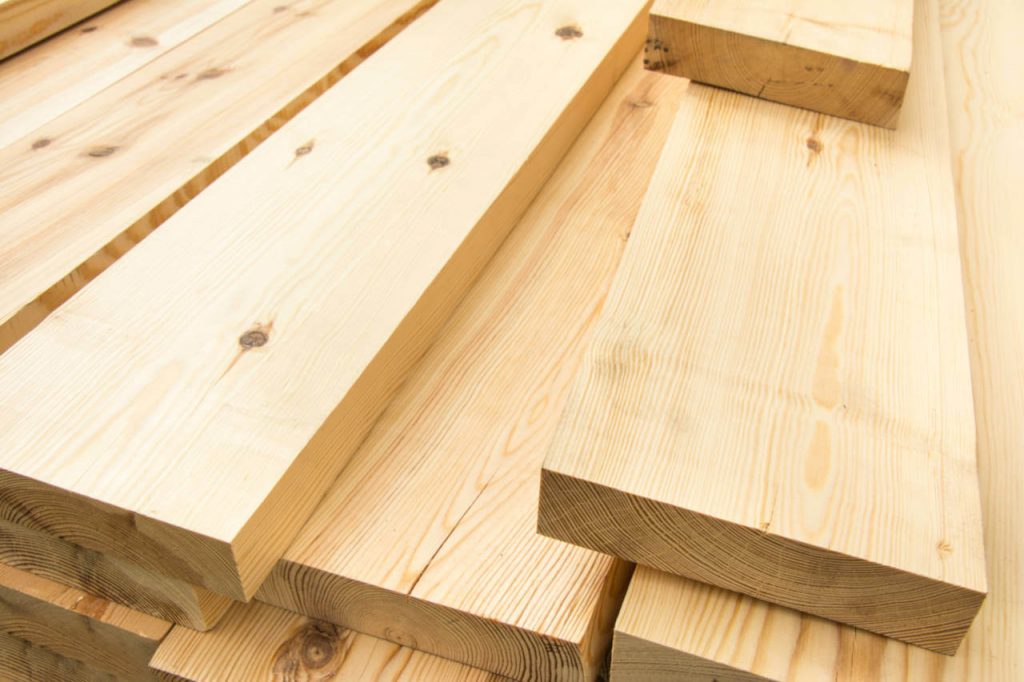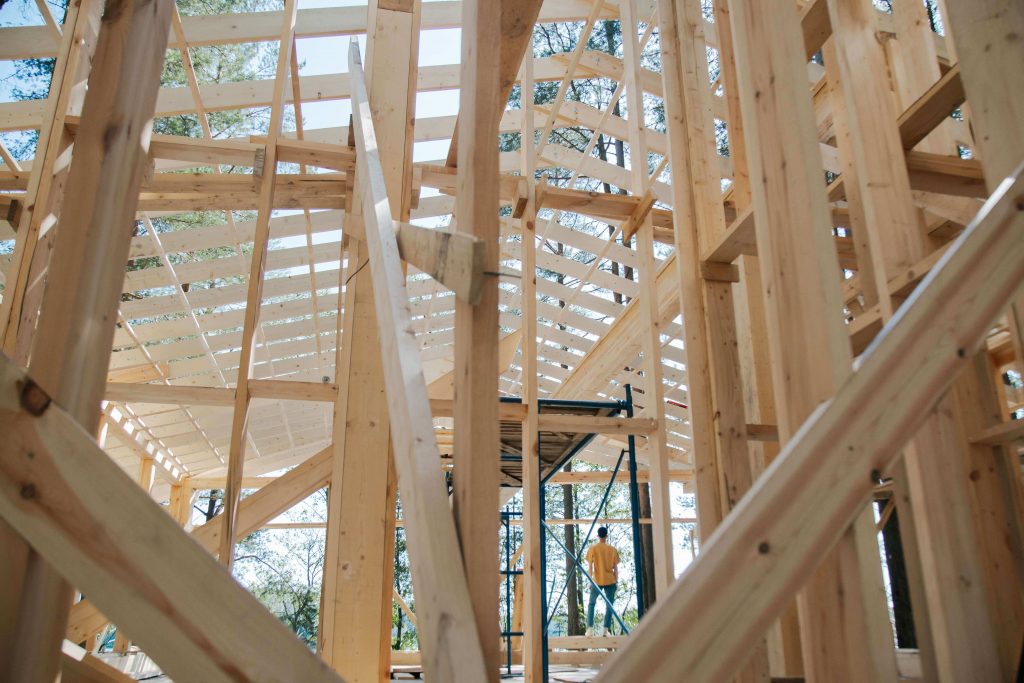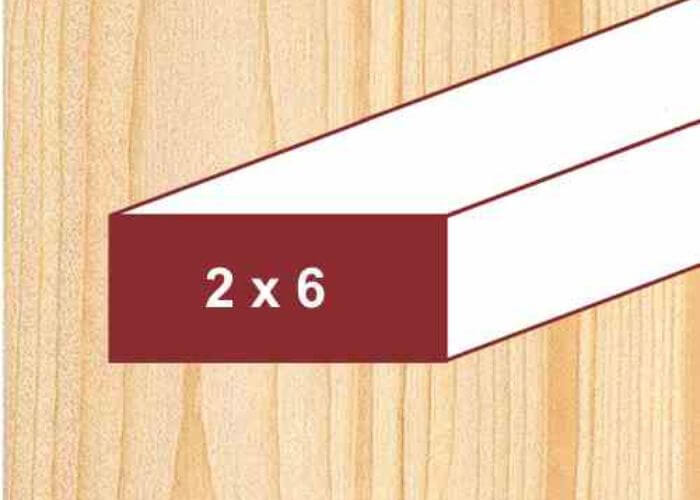In almost any DIY project involving lumber, 2×6 actual size is a popularly used measurement in the frame construction of walls.
It is the most optimum choice as it allows more space between the exterior and interior walls, which helps retain more insulation and reduces outdoor noises.
Thicker walls are an ideal choice for separating a living space and a garage, effectively screening out the garage’s clatter and commotion. So, if you’re looking for more effective soundproofing, 2×6 is your best bet.
A 2×6 is also an amazing choice for your outhouse. They are sturdy and soundproof, so you can effectively build a 1-story outhouse.
Also, with a 2×6, you don’t have to worry about vibrating walls if the door is shut a little too hard. You can also expect lower energy bills when you insulate and seal out the air infiltration correctly.
Now, if you’re new to DIY-ing a home improvement project, you might be surprised to learn that a 2×6 is not really a 2×6. Let’s dig into what is the actual size of a 2×6 and why.
Also read our article on 2×8 actual size to know everything about 2×8 lumber.
What Is A 2×6 Actual Size?

The actual size of a 2×6 is 1 1/2 inches x 5 1/2 inches.
When you use a woodworker’s tape measure to size up the 2×6 lumber piece you brought from a lumber yard or hardware store, you will notice that the dimensions do not match the ones the piece was sold at, i.e., 2×6.
This is because lumber is marketed by its nominal sizes. A nominal size refers to the dimensions according to which the lumber is originally cut. It is also the dimension used for the advertisement and sale of the lumber piece.
After being cut to its nominal size, the wood undergoes processing before it is sold. This processing involves milling, sawing, and polishing, which leads to reducing the lumber size.
This is why the resulting dimensions are slightly smaller than the nominal size and indicate the actual size of the lumber.
So, 2×6 is the nominal size and the actual size is 1 1/2 inches x 5 1/2 inches. A 2×6 is categorized as dimensional lumber.
Lumber’s Actual Dimension and Size
Dimensional lumber is wood lumber that is cut according to predefined standard sizes. A dimensional size refers to the lumber’s depth and width, not the length.
Dimensional lumber commonly refers to softwood, which typically forms the structural element in constructing residential homes. They are used in construction and framing projects and are thus an important element in various construction projects.
Their sizes are consistent throughout the country and can thus be used interchangeably throughout the house as well as between houses all over the country.
Whether you are buying softwood lumber or hardwood lumber, the product you get from the store is dimensional lumber with different nominal and actual sizes.
The nominal size or the marketed size of a 2×6 is 2×6; however, after the lumber has undergone sawing, milling, polishing, and other processing, the size reduces to 1 1/2 inches x 5 1/2 inches, which is the actual size.
Similarly, a 2×4 is actually 1 1/2 inches by 3 1/2 inches, a 2× 8 is actually 1 1/2 inches by 7 14 inches, and so on.
Basic Lumber Dimensions
The basic lumber dimensions refer to the depth and width of the lumber. So, a 2×6 indicates that the lumber is 2 inches deep and 6 inches wide.
You will notice that although a lumber piece is a cuboid with the dimensions of depth x width x length, lumber is only referred to by its depth and width and never by its length.
This is because the lumber’s length remains the same even after processing and thus, the nominal and actual lengths are almost the same. So, an 8ft long lumber will be very close to 8 ft.
Lumber Dimensions – Nominal Size And Actual Size

All dimensional lumber has a nominal and actual size. After being cut to its nominal size, the wood undergoes various forms of processing including sawing, milling, smoothing, and polishing, all of which reduce its size.
So, lumber that has been cut to a nominal size of 2×6 will not be 2×6 in actuality and instead will be 1 1/2 inches x 5 ½ inches, which is its actual size.
This size reduction is not random but follows certain rules. Take a look at this set of rules so you can determine the actual size of lumber if you know its nominal size:
- For sizes less than 1 inch, the nominal size is reduced by ¼ inch to get the actual size.
- For nominal sizes between 2 and 8, the actual size is ½ an inch smaller than the nominal size.
- When the nominal size is 8 inches or more, the actual size is ¾ inches smaller than the nominal size.
Nominal Lumber Sizes
Nominal lumber sizes are marketed and thus need to be whole numbers that are easy to remember and less confusing. And although they are not the actual size of the product, this is the size by which they are commonly known.
A 2×6, although not the actual size, is still referred to as 2×6 as it is its marketed size or nickname.
Actual Lumber Sizes
The actual size of lumber is the measurement you see when using a measuring tape to measure the store-bought lumber. For a 2×6, the actual lumber size is 1 1/2 inches x 5 ½ inches.
Read: 2×4 Actual Size
Rare Case: Nominal And Actual Dimensions Match
Although the term dimensional lumber was not coined until 1920, lumber yards have been using the current lumber dimensions since as early as the 1870s.
So, you will probably never come across nominal and actual lumber dimensions that are the same.
However, if you tear down a very old home, built before the 1870s, you will notice that the lumber is slightly larger than what you usually receive from a hardwood store. And if you measure it, you will discover that the 2×6 lumber was actually 2×6.
However, the lumber used today is standardized differently, and if you try to reuse this lumber, it will protrude out of the wall. However, you can saw it down to achieve its current standardized actual size of 1 1/2 inches x 5 ½ inches and reuse it.
Based On Material
As already established, the nominal sizes and the actual sizes of lumber are different. However, when you visit a lumber store, you will notice that not only do the sizes differ, they differ inconsistently.
So, while softwood lumber follows the above-stated rule of thumb for the difference in sizes, hardwood lumber undergoes additional polishing and therefore does not follow the same rule.
Plywood And Sheet Goods

Plywood is made up of several thin layers sandwiched together to form a strong and stable lumber piece. Like other types of wood, plywood too comes in various sizes and has different nominal and actual sizes.
However, the sizes differ only in thickness, and the nominal and actual sizes of length and width are almost the same and are hence not considered. They come in the standard nominal sizes of 1/2 inch or 3/4 inch for cabinets (23/32 actual size).
Along with processing, plywood is also graded on one or both faces. It is graded A (best with the smoothest and sanded finish), B, C, or D.
So, plywood that’s graded AA has an A grade finish on both sides, DD-graded plywood will have a D grade finish on both sides, while BC-graded plywood will have a B grade finish on one side and a C grade finish on the other.
Hardwood Lumber Lengths
Hardwood lumber lengths are never considered because the actual length is very close to the nominal size. They are available in the standard sizes of 8 ft, 10 ft, going up to 24 ft.
So, an 8 ft lumber will have a maximum length reduction of 1/4 inch, which is quite insignificant.
Hardwood Lumber Dimensions
The standardization of hardwood lumber dimensions can get quite confusing as hardwood sizing depends on two factors:
- The number of polished surfaces (one side S1S or two sides S2S).
- The standard measurement system (SMS) used for hardwood (board foot or quarter system).
Since hardwood is used to make cabinetry and furniture, it needs to be polished to smoothen its surface and remove saw marks.
Here are some of the sizes before and after polishing:
| Nominal thickness (in inches) | S1S (in inches) | S2S (in inches) |
| 1/2 | 3/8 or 9.5mm | 5/16 or 7.9mm |
| 1 | 7/8 or 22mm | 13/16 or 21mm |
| 3/2 | 11/8 or 35mm | 15/16 or 33mm |
| 2 | 29/16 or 46mm | 13/4 or 44mm |
| 3 | 45/16 or 71mm | 11/4 or 70mm |
| 4 | 61/16 or 97mm | 15/4 or 95mm |
Quarter system
When measured according to the quarter system, the thickness is measured in quarters or 1/4 inch. So, a 4/4 board is 1 inch, a 5/4 is 1 ¼ inch, a 6/4 is 1 2/4 inch, and so on.
Usually, 1/4 inch is milled down during the processing. So, if you want a 1-inch board, you will have to buy a 5/4 or 1 1/4 thick board, which will become 4/4 or 1-inch thick after processing.
Board Foot
This refers to the volume of the lumber, so a 1 board foot is 144 cubic inches. In this case, for a 1-inch thick board, the length and width are 12 inches each.
Hardwood is also not sold in standard widths, so you will need to size it according to your project.
Glue-Laminated Lumber Dimensions
Glue-laminated lumber is layers of dimensional lumber glued together by adhesives to create structurally engineered wood. Not only does glue-laminated lumber come in standard sizes, but they are also customizable.
They come in a wide range of depth, from 6 inches to 72 inches, and width ranging from 2.5 inches to 10.75 inches. Each piece has its customized length and can even surpass 100 feet.
The length and thickness of glue-laminated lumber have almost the same nominal and actual sizes. However, the nominal and actual sizes of the width differ.
Some width differences are listed below:
| Nominal width (in inches) | Actual width (in inches) |
| 3 | 2 1/4 or 5/2 |
| 6 | 5 1/8 or 11/2 |
| 10 | 8 3/4 or 35/4 |
| 12 | 10 3/4 or 43/4 |
| 16 | 14 1/4 or 57/4 |
Read also: Symbol for inches and feet.
Softwood Lumber Lengths
Softwood lumber lengths are almost the same before and after processing. This is because the milling, sawing, and other processing methods have little impact on its length. The standard size starts with 6ft and goes up to 24ft with a 2 ft increment.
Softwood Lumber Dimensions
Softwood lumber has different nominal and actual sizes, as seen in the width and thickness. The same rule of thumb is applied to softwood lumber.
FAQ
Why Is Dimensional Lumber Smaller In Comparison To Nominal Dimensions?
Lumber is cut to its nominal size and then undergoes processing that reduces its size. This is why the actual size of the dimensional lumber is smaller than the nominal size.
How Far Can A 2×6 Span?
A 2×6 can span 12 feet and 6 inches for a floor joist, 18 feet for a rafter, 20 feet and 8inches for a ceiling joist, 9 feet and 11 inches for a deck joist, 24 feet for deck board, 8 feet and 3 inches for a deck beam, and 6 feet and 1 inch for a header.
How Wide Is A 2×6 Board Actually?
A 2×6 board is actually 1 1/2 inches x 5 1/2 inches wide.
Conclusion
Dimensional lumber is available in nominal sizes that are not the lumber’s actual sizes. The nominal size refers to the dimensions of an unfinished product that has not undergone processing.
The dimensions of the final product available at the hardware store are its actual size, which is less than the nominal size. A 2×6 actual size is 1 1/2 inches x 5 1/2 inches.

